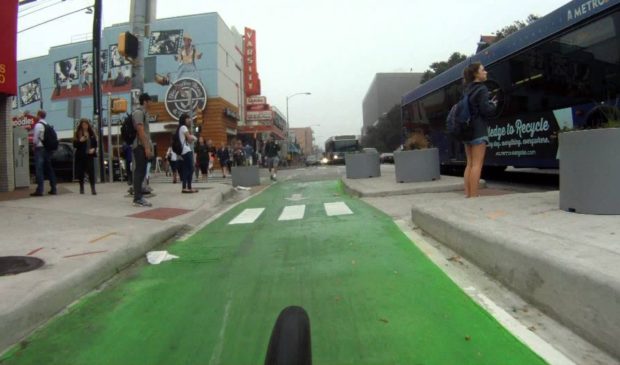Guadalupe plan still in the works
Monday, August 14, 2017 by
Caleb Pritchard The long-delayed report that will recommend giving two lanes of Austin’s iconic Drag entirely to buses is near the finish line, according to Austin Transportation Director Rob Spillar.
“If these improvements are to be considered for funding, we’ve got to get them out the door,” Spillar said of the Guadalupe Street Corridor Improvement Program’s final report. “I think we’re there. We’re just making sure everything’s lined up.”
The program was initiated in 2014. In May 2016, the Austin Transportation Department and its consultant, Kimley-Horn, released the program’s proposed recommendations, which include converting the two outside lanes of Guadalupe Street between Martin Luther King Jr. Boulevard and 29th Street into transit priority lanes. The final report was expected to be published in January, a deadline that has been decidedly blown.
“It’s just simply that we’ve been swamped. That’s the only reason,” Spillar told the Austin Monitor on Thursday. Though he said the report’s completion is imminent, he declined to offer any specific dates.
The extra workload is due in large part to the historic transportation bond that voters approved last year. City Council bound the city to an accelerated schedule in order to spend the $720 million on corridors, highways and local streets, a decision that has put the Guadalupe report on the back burner.
“Probably the biggest lag time would be on the staff side, because it needs to be reviewed by staff and having us find time to sit down and actually do those definitely delayed the process some,” explained Lee Austin, a city traffic engineer.
She also noted that the department received “last-minute” input from property owners and businesses along the Drag who expressed concern about the proposed elimination of on-street parking.
“Everybody wants to see a better Drag, but everybody has different goals,” Austin said. “And every time you change something, it’s not going to make everyone completely happy.”
Cathy Norman, president of University Area Partners, which represents stakeholders in West Campus and along the Drag, told the Monitor that some members of her group are concerned about how the loss of the parking spaces will affect how they receive deliveries. The alley behind the businesses from 22nd Street to 24th Street isn’t adequate enough to handle multiple vans or trucks, she said.
Austin explained that the staff and consultant team are weighing those concerns in the creation of the final report.
“The alley as it stands sometimes isn’t as usable as it could be,” she conceded. “So what could we do to improve the alley to make it more accessible? Could we carve out some commercial zones on some of the side streets that would be just as useful as the ones in front of the stores?”
Spillar also noted that the recommended improvements in the report might not be entirely funded with the 2016 bond money, meaning that the transit lane conversion is not guaranteed. Of the $720 million that voters approved, $482 million is earmarked to implement corridor plans such as Guadalupe Street. That money will be spread across projects along eight other arterials.
While Kimley-Horn is prioritizing the Guadalupe Street projects, city staff is also putting together a corridor project construction program that is expected to be released in early 2018.
Susan Somers, board president of AURA, a group that has rallied for the proposed changes along the Drag, urged the city to keep its eye on the ball.
“I think definitely dedicating the transit space is absolutely what we should do. And I hope we follow through,” she said.
In the meantime, as part of Project Connect, the Capital Metropolitan Transportation Authority is also considering high-capacity transit investments along the Drag, which could make the bus lane conversion moot. If that process returns a recommendation in favor of light rail along Guadalupe, planners could decide to route it up the center lanes.
Spillar said the department is coordinating with Capital Metro and operating on a policy of keeping all options on the table.
“A good example is when (the Texas Department of Transportation) has built bridges recently in the Riverside corridor. They’ve made allowances for a future rail investment and those allowances are based on specific assumptions about what those vehicles might be,” Spillar said.
Nonetheless, despite the politically tricky nature of taking scarce right of way from cars, Spillar seemed committed to the bus lane conversion, though he cautioned that the department will not pull the trigger without a thorough vetting of the contingencies.
“If the general public says, ‘Ah-ha, I get it,’ it has a much better chance of being sustainable,” Spillar said. “It’s a drag when stuff’s not sustainable.”
Image from YouTube.
The Austin Monitor’s work is made possible by donations from the community. Though our reporting covers donors from time to time, we are careful to keep business and editorial efforts separate while maintaining transparency. A complete list of donors is available here, and our code of ethics is explained here.
You're a community leader
And we’re honored you look to us for serious, in-depth news. You know a strong community needs local and dedicated watchdog reporting. We’re here for you and that won’t change. Now will you take the powerful next step and support our nonprofit news organization?









